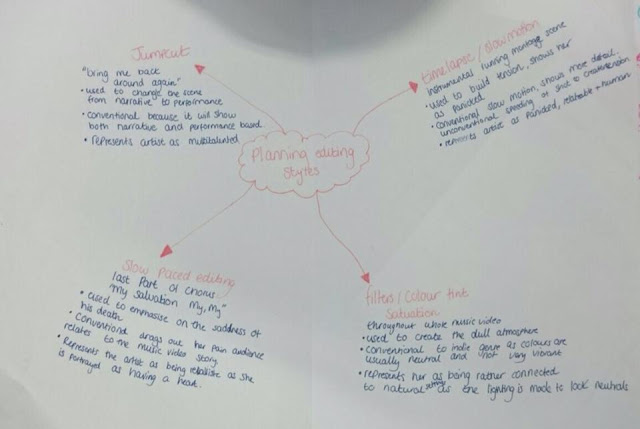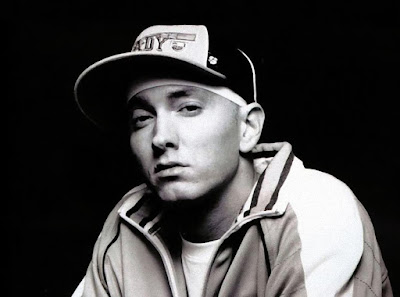The most evident reason for the need of a variety of editing styles within a music video is simply to keep the audience entertained. If the audience were watching a video with the same editing techniques used throughout, they would quickly become bored and would want to continue watching. Sticking to the most basic editing styles such as continuity editing does not achieve much; continuity editing is used to create verisimilitude, therefore it does not "WOW" the audience or make them aspire to what is being shown as it is a realistic perception and therefore a boring perception. Another reason is simply to give the music video a coherent structure so that if we wish to use analepsis or prolepsis within the video then using different editing styles will make this clear; e.g. editing a scene with a black and white filter may signify it is in the past.

One editing style my group and I chose to use within our music video is slow-paced editing. We have actually decided to employ this style throughout the entire of the video, with the exception of the London scenes which will be in a time-lapse; another editing style we have chosen. The contrast between the fast-paced shots of the city and the slow-pace of the rest of the scenes in more countryside locations, will be crucial in illustrating how the artist is feeling. Slow-paced editing is useful for highlighting sadness which is a key emotion for our narrative. In certain scenes, such as when the last chorus of the song is sung, after the male character has died, slow-paced editing will be extremely noticeable and fitting. The editing will provide a dragged out feeling to the last chorus; therefore both the artist's and consequently the audience's sadness towards the death will be extremely prolonged, effectively creating a more impacting video for the audience. In addition, the repeated lyrics of "my salvation, my, my" in the last chorus will add to the desired dragged out effect and will make the mood of the video even more depressing. This is conventional of the indie genre as often the lyrics exhibit a sense of loneliness or depression as this really allows the audience and artist to connect on a personal level. Furthermore, the indie genre like to write about matters which are relevant to their audience; relationships and break-ups are something which a lot of people go through and therefore enhances the audience-to-artist relationship. In addition, slow-pace editing is conventionally used in order to create this effect; the lyrics are quite slow and melancholic and therefore it would look rather strange to have faster-paced editing which does not match the lyrics or the beat of the music. Slow-paced editing is also effective in representing the artist as being more ordinary than extraordinary and therefore more relatable for the audience. Gabrielle Aplin is seen less as a celebrity who is unreachable but more as someone the audience can relate to, look up to, and take advice from when they are faced with similar problems in their own lives. The GIF image above demonstrates slow-pace editing; in this example, there is a use of slow-pace editing that takes one shot into another shot through a fade. I put this example in as during the beginning of my group and I's music video, we came up with an idea to use slow-pace editing to fade an image of the artist when she was old into a shot of the artist in the flashback the video is set in.
Another editing style which we have chosen to adopt are the use of jump cuts. This is due to the fact that this type of editing will allow us to effectively transition from the narrative to performance parts of the music video. Evidently, we do not want the music video to look strange and unprofessional if the types of the scenes keep changing and therefore by using jump cuts, it will be clearer that the narrative and performance parts are related. One example of where we would use a jump cut is after the artist sings the lyrics of "bring me back around again", the scene changes from narrative straight to performance. The use of a jump cut here will demonstrate to the audience that the artist is being shown in two different lights: the performance aspects are more personal as she is all alone and the narrative is to give more to the audience of what the artist is like. This is more effective than just having pure narrative or pure performance as it represents the artist in more than one way; the audience want to get to know the artist as much as possible. Furthermore, the jump cut can be used as a metaphor to illustrate the tumultuous life of the artist; the constant changing between narrative and performance gives more insight into what the artist's life is like personally as well as perhaps on a more celebrity status level. Relating to Dyer's theory, the use of jump cuts are effective in representing the artist as quite extraordinary as it shows how multi-talented she is; the music video illustrates Gabrielle Aplin as singing and playing a musical instrument. This allows the audience to form a closer relationship to the artist as well as becoming active in the video by aspiring to be more like Gabrielle. Above is an example GIF image of a piece of media using jump cuts; as you can see, jump cuts are effective when wanting to move from one shot to another in a simple manner. For my own music video, I do not want an unnecessarily complex transition between the narrative and performance scenes as the audience should not have to think about or figure out what is occurring in the video so deeply.
The final editing style my group and I have picked out is the use of filters and color alterations. We have planned to alter the saturation throughout the entire video; as it progresses, the color of the video will gradually decrease more and more. This is effective for our narrative as the mood gradually becomes more and more depressing and therefore the dullness being produced will reflect this. The funeral scene, right at the end of the music video, will be exceedingly drained of saturation to really emphasize the sadness the artist feels. In addition, this will contrast with the bright, natural lighting used at the start of the video. Using more neutral and dull colors is more conventional as the indie genre do not adhere to using vibrant colors which stand out; artists like their visuals to reflect their lyrics. The simplicity and natural feel of the lyrics and music need to be reflected by neutral and basic colors. Furthermore, we have decided to use filters to make the video look less modern and more vintage; however, we only want use a tint of filter as the music video is still going to be set in contemporary times. This is also conventional of the genre as a lot of indie music videos like to use vintage elements as it provides a better atmosphere for the most popular theme of the genre: love. Both the use of filters and color alterations is useful in representing the artist as being a lot more natural and authentic as we will use simple editing of visuals as opposed to using over-dramatic special effects like the pop genre does for instance. The image above demonstrates the use of a color alteration; subtly changing the brightness/contrast or applying a filter to a shot will have a huge impact on the mood of the shot. Therefore, it is paramount my group and I pay special attention to editing the coloring of the shots so the audience really feel the emotional intensity of the video. This is hugely beneficial to making a more successful music video.
From looking at all the styles I have used, I can say that I have both conformed and subverted the indie genre codes and conventions. Editing techniques such as slow-paced editing are extremely conventional as they create a better emotional response from the audience, due to their more intense and melancholy nature. Showing a specific clip for longer than you normally would, such as an extremely sad part of the narrative, is highly efficient as it drags out the action and therefore makes the audience feel more emotional when watching the music video. Another reason for this type of editing being conventional is because the slower the pace of the video is, the more realistic it feels; creating verisimilitude within an indie music video is extremely effective for the genre as the narrative is stereotypically based upon real life-events, such as relationships. Therefore, the audience will gain a better feel of what the artist is going through and can relate more to their situation and feelings. However, on the opposing hand, fast-pace editing subverts indie conventions, as this type of editing is stereotypically associated with genres such as pop or electronic/dance, as the music is substantially more upbeat and fast-paced; therefore, the visuals need to match for the video to work. Despite the stray of generic conventions, I still think fast-paced editing will work well for our music video, as it is powerful in adding more intensity and emotion where the tempo of the song increases. I also think that occasionally subverting conventions is important in creating a more successful video as uniqueness keeps it interesting. Furthermore, fast-paced editing will be beneficial in portraying the artist as being extraordinary as the juxtaposition between the shots of the countryside and city demonstrate the artist's busy celebrity lifestyle. However, the other two styles I have opted to use, jump cuts and color alterations, are both conventional of the indie genre. Jump cuts being a simple editing technique prove to be conventional as they reflect the simplicity of indie music. Therefore, they are appreciated by the indie audience as overly complicated editing techniques stray too much away from the genre. With regards to the use of color alterations and filters, this is a clear use of an indie convention, from researching indie music videos. Changing the color of the shot is extremely beneficial when desiring a specific emotional effect and therefore is very advantageous to use.
Conclusively, the audience is successfully able to build a relationship with the artist through the editing we have chosen as the styles are all relatively simple. Therefore, the artist can aspire to what they see as it is more realistic. In addition, adhering to simpler styles means that we can follow Goodwin's theory of matching the music and the visuals and therefore create a more successful video which will be more engaging for the audience. By using editing that allows us to show both the narrative and performance parts of the video in a coherent manner, we can give the audience more information and insight into the artist's life which will enhance the audience-to-artist relationship.
























